The Tragedy of MP3.com January 15, 2020
I’ve been obsessed lately. Up at 4am, scrubbing through the Wayback Machine. Digging through tarballs. Trying to piece together the story of what once was, and what you’ve never heard of–despite the fact that you probably should have.
What if I told you there was a site that did what iTunes did before iTunes, what Bandcamp did before Bandcamp, and what Google Play Music did before Google was even a drip of gayonnaise in Larry Page’s briefs? What if I told you the streaming revolution happened not in the 2010s, but in 1998? And what if I told you all that remains of this site are a few archived pages and four screenshots on the visible internet?

Let’s talk about MP3.com.
The short of it
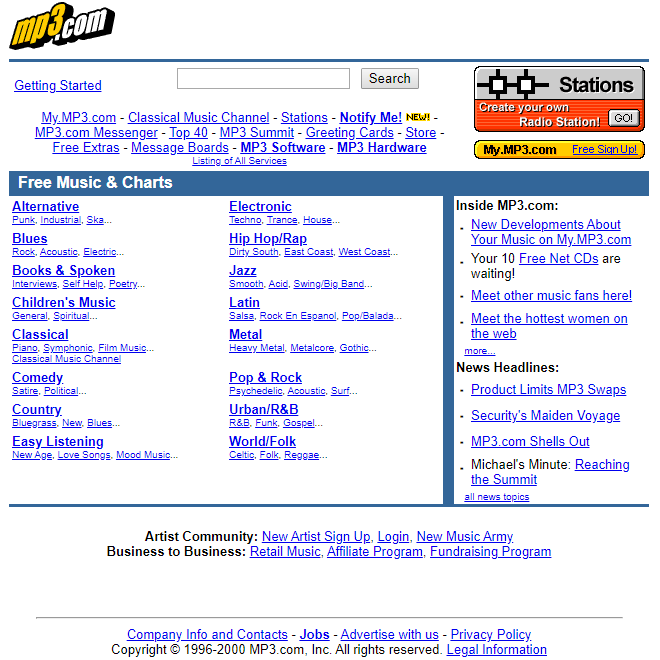
So even if you’re a mom, you probably know what an MP3 is. It’s a funny little music format that squishes down to a relatively comfortable size by sacrificing some of the sound quality–the bright side to that being it’s the bits you likely can’t hear. (I don’t think you want me to go into psychoacoustics though >_>)
The lads behind MP3.com didn’t start with the intention of making a digital music site. In the late 90s, MP3s hadn’t yet become the juggernaut that they’d later become, but among computer kids (not the woke kind), decent quality digital audio in 4MB (or less, if you were willing to put up with more artifacting) was kind of a big deal in the age of 6.4GB hard drives.
The oft-repeated story is in 1997, Michael Robertson noticed some spikes in searching for MP3s on his (now utterly obscure) FTP search engine Filez.com. Thinking it’d drive some good traffic to Filez, he bought the MP3.com domain for a grand off someone whose online alias was quite literally MP3. Initially, he just hosted links to MP3 encoders and music news, but that wasn’t enough. People came to MP3.com for MP3s, surprisingly enough. He tried to court labels into distributing their music through his site, but trailblazers that they were, they didn’t see the point.
Of course, with a thriving indie scene struggling to distribute music over the internet of the day, Michael went to the bands instead. It worked.
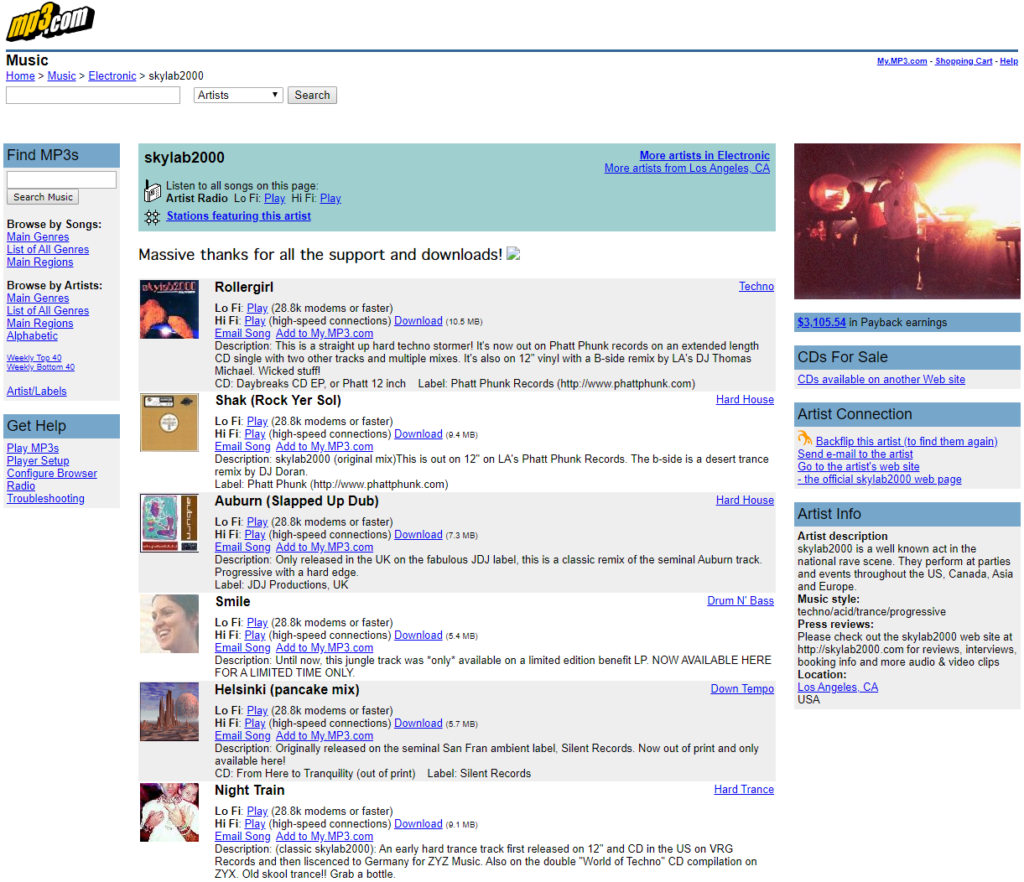
At its sale to Vivendi, MP3.com was shifting four million MP3s a day to 800,000 unique users, about a gigabyte of traffic globally every second, or about four terabytes monthly. Bands fuckin’ adored the place. They could sell off downloads, made-to-order CD-Rs of their work, and monetize their streaming traffic in the most soothsayer way possible–stream our tracks and we get royalties from it.
So MP3.com had a business model that iTunes and later Spotify would take to the goddamn bank and everyone loved it. How’d it fall?
Well, the labels, of course. You might wonder how the labels had an issue with indie bands, and the answer is, they didn’t. It all came down to a funny little thing called My.MP3.com. The service, again far too ahead of its time for its own good, was the late 90s equivalent of Google Play Music or iTunes Match. You’d register your CDs with it and MP3.com would let you download and stream them anywhere. Michael’s reasoning? To grow MP3.com further, they’d have to move past simply streaming the music of nobodies and stream the music of somebodies. I mean, they already had Alanis Morrissette behind them; why not?
Labels got antsy. To them, this was dangerous, copyright-infringing territory that’d kill their future business prospects in this strange new realm, and UMG personally sat up to smash MP3.com’s femurs in court. The case was later settled and My.MP3.com discontinued, but the dot-com bubble had just popped and the whole money thing wasn’t panning out for startups like MP3.com. As a result, they sold to Vivendi in 2001, who really couldn’t do jack or shit with the service and sold it again to CNET, who promptly shut it down.
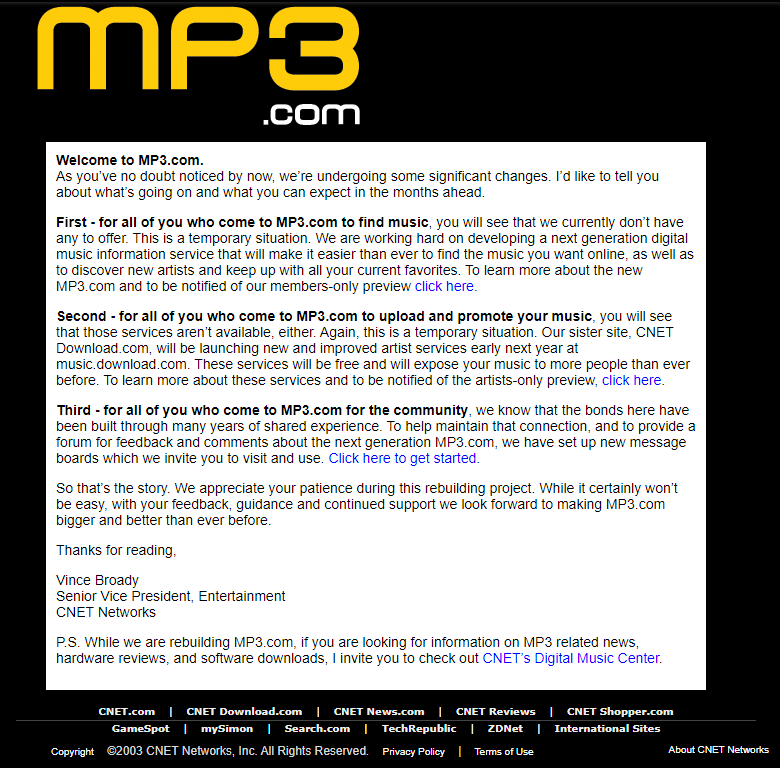
CNET promised replacement services, but that never came to pass. It mostly sat its fat ass on the name and assets. Trusonic, one of MP3.com’s divisions, partnered with an MP3.com competitor in GarageBand.com to allow some 1.7 million tracks (supposedly “most” of the full library, but finding specifics is rough) to see the light of day again, but that wasn’t in the cards either. (GarageBand.com has since folded and now Apple owns the domain for their cut-down Logic clone of the same name.)
And what became of it all? MP3.com is now a cheesy discount music-focused Buzzfeed, the library is now tied up in acquisition after acquisition if not outright lost, and the story has all but faded from the internet. As said, four measly screenshots still exist of the service, aside from my own featured here.
The same people who crow about the loss of Geocities don’t even realize how many other Geocities existed at the time, and they all died the exact same death. Don’t think your new favorite toy site is safe.
To archive
Stymieing archival attempts was the fact that MP3.com streamed through a CGI script and thus spiders couldn’t touch any of the actual music. So ignoring that, what did get saved? The Wayback Machine, of course, has a partial archive of the pages (and a partial archive of their assets), but that’s nothing special, really. Archiveteam’s working on collecting all of the made-to-order CD-Rs, but their records of them aren’t great and not every MP3.com artist used the CD-R service.
As far as the site itself goes, though, there’s a skeleton archive that at least gives us an overview of what was available. Now, it’s only artist pages and no stylesheets or images, but that’s better than nothing.
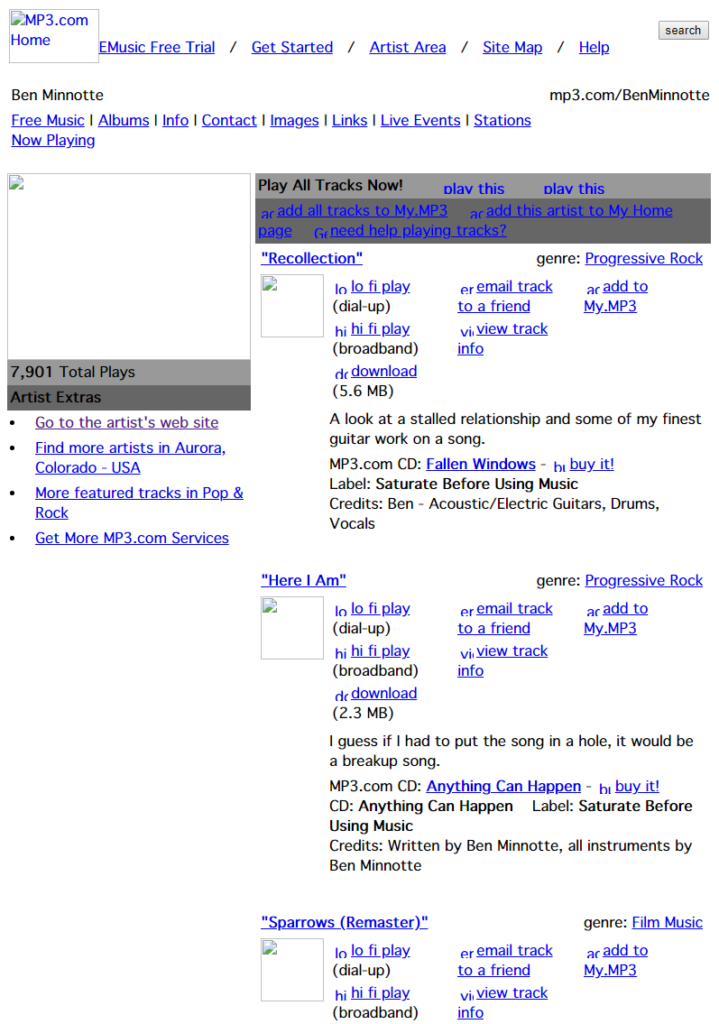
As for some of the details of the service and what artists were capable of on it, I’m still a little shaky.
- It seems artists had the ability to customize their profile to some degree–I’ve seen ones with custom backgrounds, ones with blurbs (complete with images!), custom colors, the works.
- I imagine the made-to-order CD-Rs were of the same MP3s the artists would upload through the service–I mean, not like lossless was much of a thing yet. Seems like it defeats the point of a CD to have mid-fi MP3s on it, but hey, what the fuck do I know.
- As far as streaming goes, “lo-fi” play streamed in 24kbps and “hi-fi” play in 128kbps. Downloads were 128kbps. As for the streaming format, I’m not sure. I know it sounds obvious, but I didn’t even really know MP3 as a streaming format compared to, say, RA or ASF. Apparently it could be used that way though, so I’m gonna go with MP3 through a CGI script.
- Of note is that MP3.com got a redesign in ~2003 that changed the logo and made everything a whole lot more yellow. The skeleton archive is of the later pages.
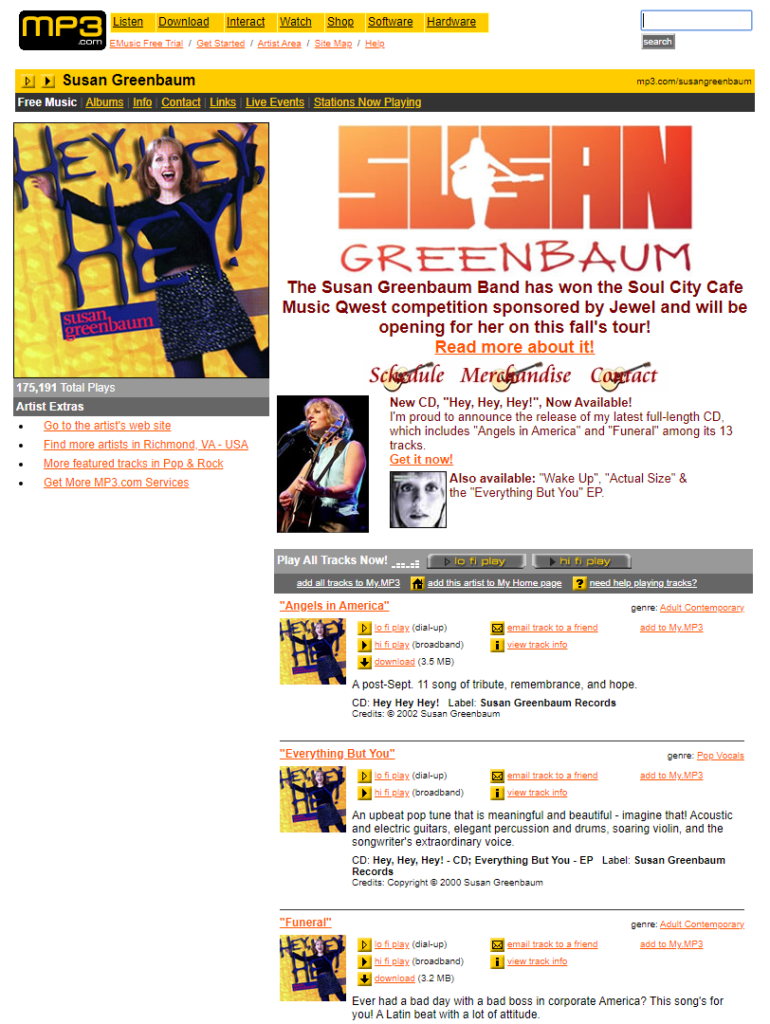
Closing up shop
Some people are uniquely pragmatists when it comes to archival. They see the user-created landfills of MP3.com and any number of other sites as being, well, landfills. “Archive enough to get the point across and move on,” they’ll probably say. Hell, some will say it’s a waste of time to save this shit at all.
When sites like MP3.com die, millions of manhours are poofed from existence. Each track holds personal significance to someone; more importantly, they’re an artifact in time. Seeing these user-generated monoliths die time and time again is enough to blackpill a man. Have a peek at this little eulogy for it, from a saxophonist who used MP3.com to promote his own music. What he talks of–the traffic, the back catalog, the statkeeping, the promotion he got through it–it’s no bullshit.
MP3.com served every genre under the sun. I don’t listen to jazz. I barely know any jazz whatsoever. Yet it served them as much as it served indie weirdos with beat-up guitars and 4-trackers, as much as it served shitty bedroom trance musicians–MP3.com had a scrappy little spirit, a spirit that more than likely lives on in a Bandcamp or a ReverbNation to this day.
But there’s no denying that we lost history when MP3.com shut down. Given how tough it is to find anything, anything of value on the service to this day without diving into obscure Internet Archive uploads and secondary sources from the blogs of the day, it’s safe to say we haven’t taken that loss heavily enough, nor have we learned anything from it.
Keep your backups. Save everything you’d like to keep. It might get bought by CNET one day.
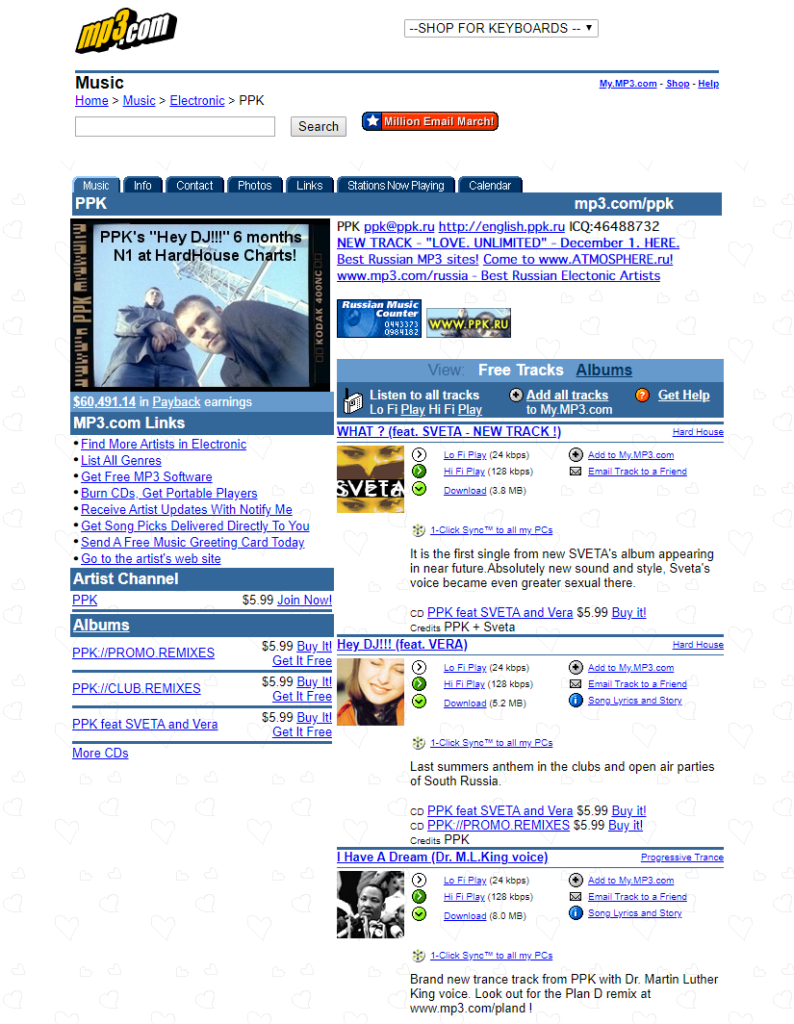
Edit: hey, I ended up writing about MP3.com a lot more than expected when this was first penned. Some of the stuff I was still shaky about when I wrote this eventually cleared up with more digging. Here’s the direct followups if you’re curious:
And in case I do any more with it, here’s the relevant blog tag. Thanks for reading!
Tags: MP3.com, My Music Collection,
5 comments on "The Tragedy of MP3.com"
Comments are closed.
Hosted by DreamHost. mini.css so gracefully developed by @Chalarangelo, bless em.
Just ran across your blog by chance. I’ve been posting old tracks off and on mostly from the electronic library since 2010 on youtube. Check out the channel:
http://www.youtube.com/c/jsims85
Wow, good selection! Really glad to see some of this finding its way back online.
Out of curiosity, where’d you get it all, and are you posting the raw MP3s somewhere else for posterity? I’d love to look through that archive, plus listen without all of YouTube’s extra processing.
Really great article.
I’m also very interested in finding archives of old MP3.com music.
In particular, I’m trying to find the “Rhythmic Flotations” album by Bassic. I’ve found nearly everything else, just not that.
And anything by The Seraphs.
Keep up the good work!
I spent quite a bit of time spidering the net and had a few CDs from back in the day. Some stuff is easy to find as artists have their own pages. There’s still Reverbnation, Soundclick, Soundcloud, Bandcamp, Spotify, etc. where many artists moved.
Most of the super obscure stuff went bye-bye. I’ll get around to serving these files eventually. Plenty of people still out there sitting on drives/spindles full of tracks.
Yeah, thankfully, all the ones I found in writing this still had their MP3.com stuff survive in some capacity, at least. If not out on the greater internet, the people behind it later posted it again themselves. Is good to see. Even if a lot of it disappeared, maybe having a post like this will motivate someone to dig up their own archives of them.
And on that note, honestly, I was about to offer potentially hosting them myself, if you’d like. DreamHost isn’t exactly stingy with that infinite space deal, and they’re rather low bitrate MP3s anyway. Hosted a lot bigger on this site, I know that.